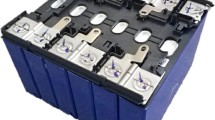Abstract
To realize the idea of accommodating wind power nearby the aluminum plant and achieving a win–win situation in China, a great deal of basic research is still necessary. In this study, a transiently strongly coupled model of thermo-electric field was developed, in order to explore the dynamic characteristics of temperature distributions and heat dissipation in aluminum electrolysis cell under current enhancement. The results show that when the current is enhanced by no more than 10% within 2 h, the profile of the ledge varies little. The higher the current is, the faster the temperature of the bath rises and the more difficult it is to restore to the normal state (948.2 °C) in a short time (2 h). The heat dissipation rate of the upper part of cell change obviously compared to the other parts, but little in rising ratio. Therefore, four methods to adjust heat dissipation were modeled and the result shows it is effective to decrease the temperature to the normal state in a short time.











Similar content being viewed by others

References
Zhang H, Ran L, He G et al (2017) Analysis and countermeasures of wind power accommodation by aluminum electrolysis pot-lines in China. Metall Mater Trans B 48:2526–2534
Li J, Lv XJ, Zhang HL, Liu YX (2013) Development of low-voltage energy-saving aluminum reduction technology. In: Sadler B (ed) Light metals 2013. TMS, San Antonio, pp 557–559
Béran P, Kaenel RV, Lange HP (2001) Impact of current increase on specific energy consumption. In: Anjier JL (ed) Light metals 2001. TMS, Louisiana, pp 179–184
Xu SS (2013) Study and application on current intensifying and simulation of thermal-electric field in pre baked anode aluminum reduction cell. Master’s thesis, Central South University, Changsha (in Chinese)
Li HS, Mei C (2004) Finite element analysis of thermo-electric coupled field in aluminum reduction cell. Chin J Nonferrous Met 14:854–859
Dupuis M (1998) Computation of aluminum reduction cell energy balance using ANSYS® finite element models. In: Welch B (ed) Light metals 1998. TMS, San Antonio, pp 409–418
Xu YJ, Li J, Yin CG et al (2014) Method of strongly coupled modeling and computing for thermal-electrical field in aluminium reduction cells. Chin J Nonferrous Met 24:239–245
Solheim A (2011) Some aspects of heat transfer between bath and side ledge in aluminum reduction cells. In: Lindsa J (ed) Light metals 2011. TMS, San Diego, pp 381–386
Severo DS, Gusberti V (2009) A modeling approach to estimate bath and metal heat transfer coefficients. In: Bearne G (ed) Light metals 2009. TMS, San Francisco, pp 557–562
Cui XF, Zou Z, Zhang HL (2012) Simulation calculation of 3D freeze profile in prebaked aluminum reduction cells. J Cent South Univ (Sci Technol) 43:815–820
Acknowledgements
This study was supported by the National Key Research and Development Program of China (2017YFC0210406), the National Science Foundation of China projects (51674300, 51574289, 61533020, and 61621062), and the Fundamental Research Funds for the Central Universities of Central South University (1053320170371).
Author information
Authors and Affiliations
Corresponding author
Ethics declarations
Conflict of interest
The authors declare that they have no conflict of interest.
Additional information
The contributing editor for this article was S. Kitamura.
Rights and permissions
About this article
Cite this article
Zhang, H., Ran, L., Zou, Z. et al. Effect of Current Transient Enhancement on Thermal Field of Aluminum Electrolysis Cell for the Accommodation of Wind Power. J. Sustain. Metall. 4, 359–366 (2018). https://doi.org/10.1007/s40831-018-0177-1
Published:
Issue Date:
DOI: https://doi.org/10.1007/s40831-018-0177-1



